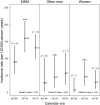Risk of anal cancer in HIV-infected and HIV-uninfected individuals in North America
- PMID: 22291097
- PMCID: PMC3297645
- DOI: 10.1093/cid/cir1012
Risk of anal cancer in HIV-infected and HIV-uninfected individuals in North America
Abstract
Background: Anal cancer is one of the most common cancers affecting individuals infected with human immunodeficiency virus (HIV), although few have evaluated rates separately for men who have sex with men (MSM), other men, and women. There are also conflicting data regarding calendar trends.
Methods: In a study involving 13 cohorts from North America with follow-up between 1996 and 2007, we compared anal cancer incidence rates among 34 189 HIV-infected (55% MSM, 19% other men, 26% women) and 114 260 HIV-uninfected individuals (90% men).
Results: Among men, the unadjusted anal cancer incidence rates per 100 000 person-years were 131 for HIV-infected MSM, 46 for other HIV-infected men, and 2 for HIV-uninfected men, corresponding to demographically adjusted rate ratios (RRs) of 80.3 (95% confidence interval [CI], 42.7-151.1) for HIV-infected MSM and 26.7 (95% CI, 11.5-61.7) for other HIV-infected men compared with HIV-uninfected men. HIV-infected women had an anal cancer rate of 30/100 000 person-years, and no cases were observed for HIV-uninfected women. In a multivariable Poisson regression model, among HIV-infected individuals, the risk was higher for MSM compared with other men (RR, 3.3; 95% CI, 1.8-6.0), but no difference was observed comparing women with other men (RR, 1.0; 95% CI, 0.5-2.2). In comparison with the period 2000-2003, HIV-infected individuals had an adjusted RR of 0.5 (95% CI, .3-.9) in 1996-1999 and 0.9 (95% CI, .6-1.2) in 2004-2007.
Conclusions: Anal cancer rates were substantially higher for HIV-infected MSM, other men, and women compared with HIV-uninfected individuals, suggesting a need for universal prevention efforts. Rates increased after the early antiretroviral therapy era and then plateaued.
Figures


References
-
- Grulich AE, van Leeuwen MT, Falster MO, Vajdic CM. Incidence of cancers in people with HIV/AIDS compared with immunosuppressed transplant recipients: a meta-analysis. Lancet. 2007;370:59–67. - PubMed
-
- Diamond C, Taylor TH, Aboumrad T, Bringman D, Anton-Culver H. Increased incidence of squamous cell anal cancer among men with AIDS in the era of highly active antiretroviral therapy. Sex Transm Dis. 2005;32:314–20. - PubMed
Publication types
MeSH terms
Grants and funding
- K01 AI071725/AI/NIAID NIH HHS/United States
- R01 DA004334/DA/NIDA NIH HHS/United States
- U01 AI034993/AI/NIAID NIH HHS/United States
- P30 AI027767/AI/NIAID NIH HHS/United States
- U01 AI035042/AI/NIAID NIH HHS/United States
- U01-AI38855/AI/NIAID NIH HHS/United States
- CBR-86906/CAPMC/ CIHR/Canada
- U01 AI069434/AI/NIAID NIH HHS/United States
- R24-AI067039/AI/NIAID NIH HHS/United States
- U01-AI-35043/AI/NIAID NIH HHS/United States
- R01 DA011602/DA/NIDA NIH HHS/United States
- U01-AI-35042/AI/NIAID NIH HHS/United States
- R01 MH054907/MH/NIMH NIH HHS/United States
- U01-AI-42590/AI/NIAID NIH HHS/United States
- Z01 CP010176/ImNIH/Intramural NIH HHS/United States
- R56 DA004334/DA/NIDA NIH HHS/United States
- AI-69432/AI/NIAID NIH HHS/United States
- TGF-96118/CAPMC/ CIHR/Canada
- U01 AI031834/AI/NIAID NIH HHS/United States
- HCP-97105/CAPMC/ CIHR/Canada
- K01-AI071754/AI/NIAID NIH HHS/United States
- U01-AI38858/AI/NIAID NIH HHS/United States
- UM1 AI069434/AI/NIAID NIH HHS/United States
- U01 AI035004/AI/NIAID NIH HHS/United States
- UM1 AI069432/AI/NIAID NIH HHS/United States
- P30 AI054999/AI/NIAID NIH HHS/United States
- R01-DA04334/DA/NIDA NIH HHS/United States
- 5-M01-RR-00052/RR/NCRR NIH HHS/United States
- U01- HD-32632/HD/NICHD NIH HHS/United States
- U01 AI038855/AI/NIAID NIH HHS/United States
- AI-69434/AI/NIAID NIH HHS/United States
- CDC200-2006-18797/PHS HHS/United States
- U01-AI68636/AI/NIAID NIH HHS/United States
- UL1 RR024131/RR/NCRR NIH HHS/United States
- U01 AI034989/AI/NIAID NIH HHS/United States
- U01-AI68634/AI/NIAID NIH HHS/United States
- R01-MH54907/MH/NIMH NIH HHS/United States
- KRS-86251/CAPMC/ CIHR/Canada
- U01-AI-35041/AI/NIAID NIH HHS/United States
- U01-AI-34994/AI/NIAID NIH HHS/United States
- AHQ290-01-0012/PHS HHS/United States
- K23-AI-61-0320/AI/NIAID NIH HHS/United States
- CBR-94036/CAPMC/ CIHR/Canada
- U01 AI035041/AI/NIAID NIH HHS/United States
- R24 AI067039/AI/NIAID NIH HHS/United States
- U01-AI069918/AI/NIAID NIH HHS/United States
- U01-AA013566/AA/NIAAA NIH HHS/United States
- U01-AI-35004/AI/NIAID NIH HHS/United States
- U01 AI069432/AI/NIAID NIH HHS/United States
- K01 AI071754/AI/NIAID NIH HHS/United States
- P30-AI50410/AI/NIAID NIH HHS/United States
- U01-AI-31834/AI/NIAID NIH HHS/United States
- U01 AI038858/AI/NIAID NIH HHS/United States
- UL1-RR024131/RR/NCRR NIH HHS/United States
- R01-DA12568/DA/NIDA NIH HHS/United States
- U01 AI068636/AI/NIAID NIH HHS/United States
- K24-00432/PHS HHS/United States
- U01 AI034994/AI/NIAID NIH HHS/United States
- M01 RR000052/RR/NCRR NIH HHS/United States
- U01 AA020790/AA/NIAAA NIH HHS/United States
- U01-AI-35040/AI/NIAID NIH HHS/United States
- P30-AI27757/AI/NIAID NIH HHS/United States
- P30 AI027763/AI/NIAID NIH HHS/United States
- R01 AG026250/AG/NIA NIH HHS/United States
- U01 AI069918/AI/NIAID NIH HHS/United States
- RR025747/RR/NCRR NIH HHS/United States
- U01 AA013566/AA/NIAAA NIH HHS/United States
- N02 CP055504/CP/NCI NIH HHS/United States
- U01 AI035043/AI/NIAID NIH HHS/United States
- U01-AI-34993/AI/NIAID NIH HHS/United States
- P30 AI027757/AI/NIAID NIH HHS/United States
- UL1 RR025747/RR/NCRR NIH HHS/United States
- R01 DA012568/DA/NIDA NIH HHS/United States
- U01-AI-35039/AI/NIAID NIH HHS/United States
- P30-AI27767/AI/NIAID NIH HHS/United States
- U01 AI035040/AI/NIAID NIH HHS/United States
- R01-DA11602/DA/NIDA NIH HHS/United States
- K01-AI071725/AI/NIAID NIH HHS/United States
- 169621/CAPMC/ CIHR/Canada
- U01 AI035039/AI/NIAID NIH HHS/United States
- U01-AI-34989/AI/NIAID NIH HHS/United States
- U01 AI068634/AI/NIAID NIH HHS/United States
- P30 AI050410/AI/NIAID NIH HHS/United States
- U01 HD032632/HD/NICHD NIH HHS/United States
- U01 AI042590/AI/NIAID NIH HHS/United States
- P30-AI54999/AI/NIAID NIH HHS/United States

